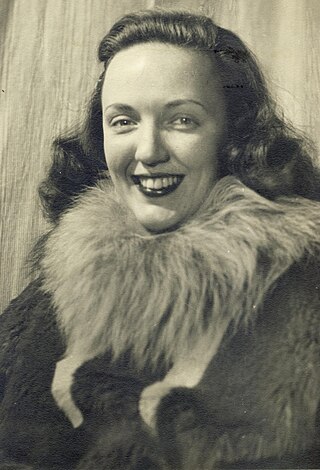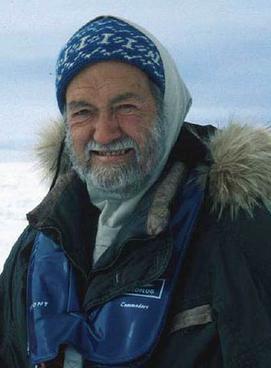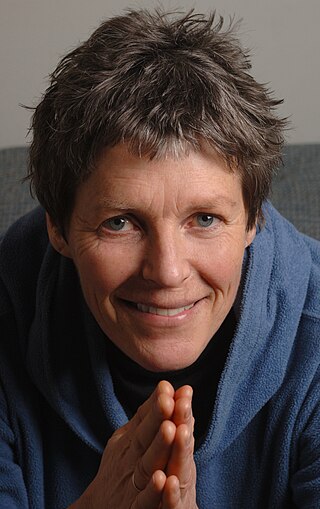Related Research Articles

Ann Bancroft is an American author, teacher, adventurer, and public speaker. She was the first woman to finish a number of expeditions to the Arctic and Antarctic. She was inducted into the National Women's Hall of Fame in 1995.

Mount Garibaldi is a dormant stratovolcano in the Garibaldi Ranges of the Pacific Ranges in southwestern British Columbia, Canada. It has a maximum elevation of 2,678 metres and rises above the surrounding landscape on the east side of the Cheakamus River in New Westminster Land District. In addition to the main peak, Mount Garibaldi has two named sub-peaks. Atwell Peak is a sharp, conical peak slightly higher than the more rounded peak of Dalton Dome. Both were volcanically active at different times throughout Mount Garibaldi's eruptive history. The northern and eastern flanks of Mount Garibaldi are obscured by the Garibaldi Névé, a large snowfield containing several radiating glaciers. Flowing from the steep western face of Mount Garibaldi is the Cheekye River, a tributary of the Cheakamus River. Opal Cone on the southeastern flank is a small volcanic cone from which a lengthy lava flow descends. The western face is a landslide feature that formed in a series of collapses between 12,800 and 11,500 years ago. These collapses resulted in the formation of a large debris flow deposit that fans out into the Squamish Valley.

Jackie Ronne was an American explorer of Antarctica and the first woman in the world to be a working member of an Antarctic expedition (1947–48). She is also the namesake of the Ronne Ice Shelf.

Sir Walter William Herbert was a British polar explorer, writer and artist. In 1969 he became the first man fully recognized for walking to the North Pole, on the 60th anniversary of Robert Peary's disputed expedition. He was described by Sir Ranulph Fiennes as "the greatest polar explorer of our time".

Troll is a Norwegian research station located at Jutulsessen, 235 kilometres (146 mi) from the coast in the eastern part of Princess Martha Coast in Queen Maud Land, Antarctica. It is Norway's only all-year research station in Antarctica, and is supplemented by the summer-only station Tor. Troll is operated by the Norwegian Polar Institute and also features facilities for the Norwegian Meteorological Institute and the Norwegian Institute for Air Research.
Richard Weber, is a Canadian Arctic and polar adventurer. From 1978 to 2006, he organized and led more than 45 Arctic expeditions. Richard is the only person to have completed six full North Pole expeditions.

Liv Ragnheim Arnesen is a Norwegian educator, cross-country skier, adventurer, guide, and motivational speaker. Arnesen led the first unsupported women’s crossing of the Greenland Ice Cap in 1992. In 1994, she made international headlines becoming the first woman in the world to ski solo and unsupported to the South pole. – a 50-day expedition of 745 miles (1,200 km).
Eric Philips OAM is an Australian polar explorer, adventurer and polar guide.

Silver Explorer is an expedition ship operated by Silversea Cruises. The ship typically hosts cruises to Norway, the South Pacific, and Antarctica. It is the first ship of Silversea involved in expedition cruising.

The South Pole, also known as the Geographic South Pole, Terrestrial South Pole or 90th Parallel South, is the southernmost point on Earth and lies antipodally on the opposite side of Earth from the North Pole, at a distance of 12,430 miles in all directions. It is one of the two points where Earth's axis of rotation intersects its surface.
Huw Lewis-Jones is a British historian, editor, broadcaster and art director. Formerly a historian and Curator of Art at the Scott Polar Research Institute, University of Cambridge, Lewis-Jones left Cambridge in June 2010 to pursue book and broadcasting projects. He is the Editorial Director of the independent publishing company Polarworld.

Antarctic was a Swedish steamship built in Drammen, Norway, in 1871. She was used on several research expeditions to the Arctic region and to Antarctica from 1898 to 1903. In 1895 the first confirmed landing on the mainland of Antarctica was made from this ship.

An ice cap climate is a polar climate where no mean monthly temperature exceeds 0 °C (32 °F). The climate generally covers areas at high altitudes and polar regions, such as Antarctica and some of the northernmost islands of Canada and Russia. Most of Greenland is under the influence of an ice cap climate, although the coasts are prone to more influence from the sea, providing more tundra climates. Some regions on the islands of Norway's Svalbard Archipelago facilitate an ice cap climate. Areas with ice cap climates are normally covered by a permanent layer of ice and have no vegetation. There is limited animal life in most ice cap climates, which are usually found near the oceanic margins. Although ice cap climates are inhospitable to human life and no civilian communities lie in such climates, there are some research stations scattered in Antarctica and interior Greenland.

Ingebrigtsenbukta is a bay at the south shore of Van Keulenfjorden inside Sør-Spitsbergen National Park. The bay is approximately 3 km wide, running from Kapp Toscana in the west to Ålesundneset in the east. The bay was named after Norwegian whaler Morten Andreas Ingebrigtsen.
Ellen Mosley-Thompson is a glaciologist and climatologist. She is a Distinguished University Professor at The Ohio State University and director of their Byrd Polar and Climate Research Center. She is known as a pioneer in the use of ice cores from the Polar Regions for paleoclimatic research and is an influential figure in climate science. She is an elected fellow of the American Association for the Advancement of Science, the American Geophysical Union and an elected member of the National Academy of Sciences.

There may have been women in Antarctica and exploring the regions around Antarctica for many centuries. The most celebrated "first" for women was in 1935 when Caroline Mikkelsen became the first woman to set foot on one of Antarctica's islands. Early male explorers, such as Richard Byrd, named areas of Antarctica after wives and female heads of state. As Antarctica moved from a place of exploration and conquest to a scientific frontier, women worked to be included in the sciences. The first countries to have female scientists working in Antarctica were the Soviet Union, South Africa and Argentina.

This is a Timeline ofwomen in Antarctica. This article describes many of the firsts and accomplishments that women from various countries have accomplished in different fields of endeavor on the continent of Antarctica.
Aithne Rowse is an anaesthetist who was the first South African woman to over-winter in Antarctica.
Hilde Fålun Strøm is from Svalbard, Norway and is an explorer, polar ambassador and citizen scientist with over 20 years experience working in the polar regions. In 2017, with Sunniva Sorby, she started Hearts in the Ice, a platform for social engagement around citizen science and climate change.
References
- 1 2 3 4 5 6 7 "Adventure women: Polar Explorer Sunniva Sorby | Signature Luxury Travel". Signature Luxury Travel & Style. 2018-07-24. Retrieved 2020-03-08.
- 1 2 3 4 5 "About". Hearts In The Ice. Retrieved 2020-03-08.
- 1 2 "Squamish woman preparing for nine-month Arctic research project". Squamish Chief. Retrieved 2020-03-08.
- 1 2 "Fellows Journal Spring 2019 - The Royal Canadian Geographical Society". rcgs.org. Retrieved 2020-03-08.
- 1 2 "Ann Bancroft - Speaker Profile". keynotespeakers.com. Retrieved 2020-03-09.
- 1 2 The Victory Winter 1994. Trafalgar School for Girls. Trafalgar School for Girls. 1994.
{{cite book}}: CS1 maint: others (link) - 1 2 "Athenaeum Location | Claremont McKenna College". cmc.edu. Retrieved 2020-03-08.
- 1 2 "Q&A with Hearts in the Ice Founders Sunniva Sorby and Hilde Falun Strom". Iridium Satellite Communications. 2020-01-27. Retrieved 2020-03-08.
- ↑ "Bamsebu Team". Hearts In The Ice. Retrieved 2020-03-08.
- ↑ "The Gazette from Montreal, Quebec, Quebec, Canada on June 30, 1997 · 60". Newspapers.com. Retrieved 2020-03-08.
- ↑ DeWyze, Jeannette (July 27, 2000). "San Diegan Sunniva Sorby treks to South Pole". sandiegoreader.com. Retrieved 2020-03-08.
- ↑ "Home". Hearts In The Ice. Retrieved 2020-03-08.